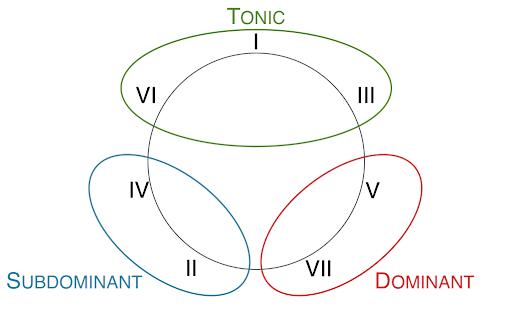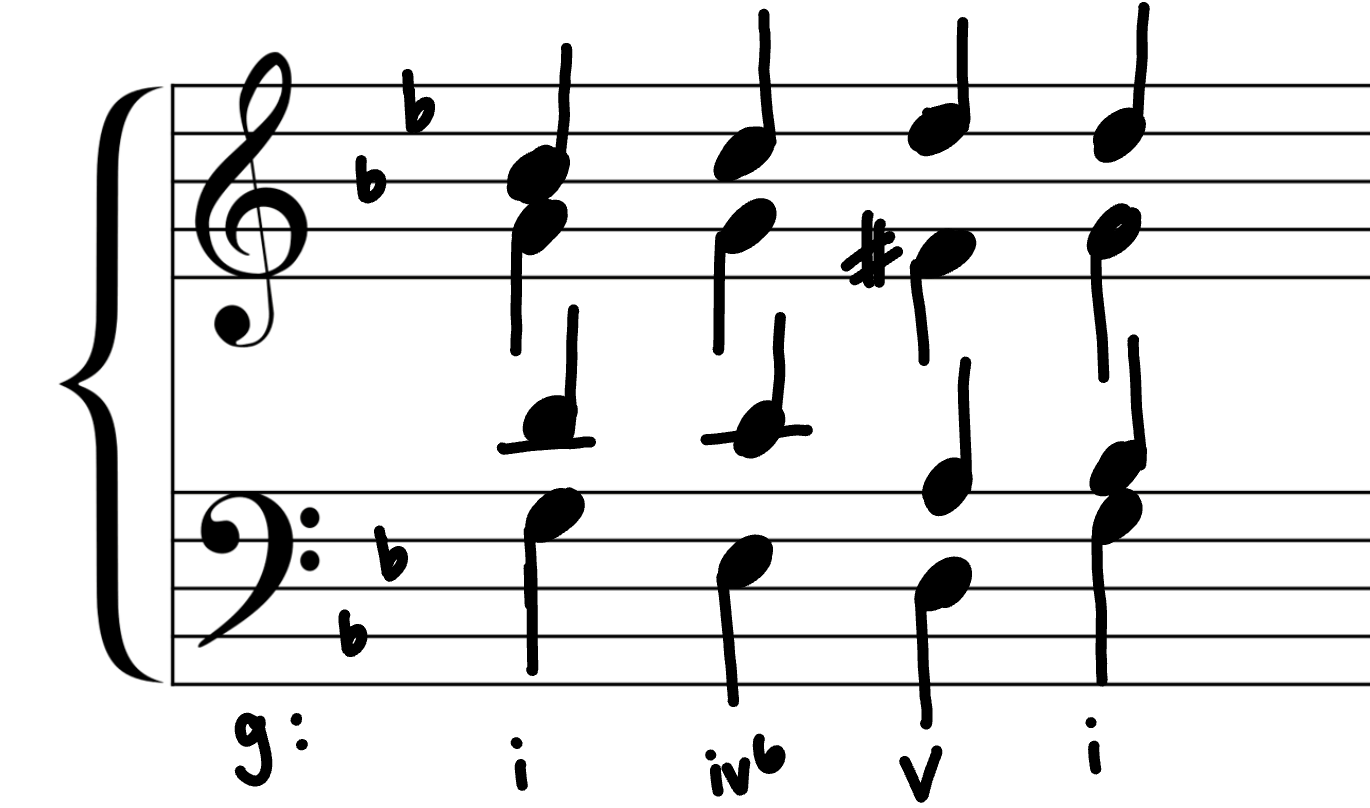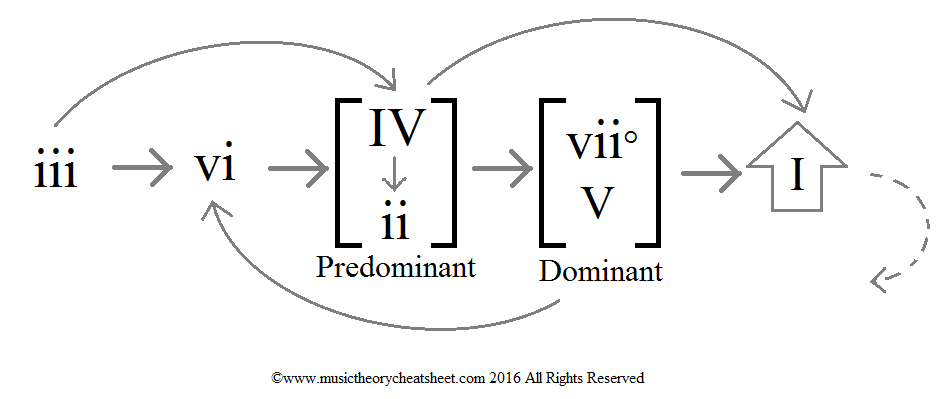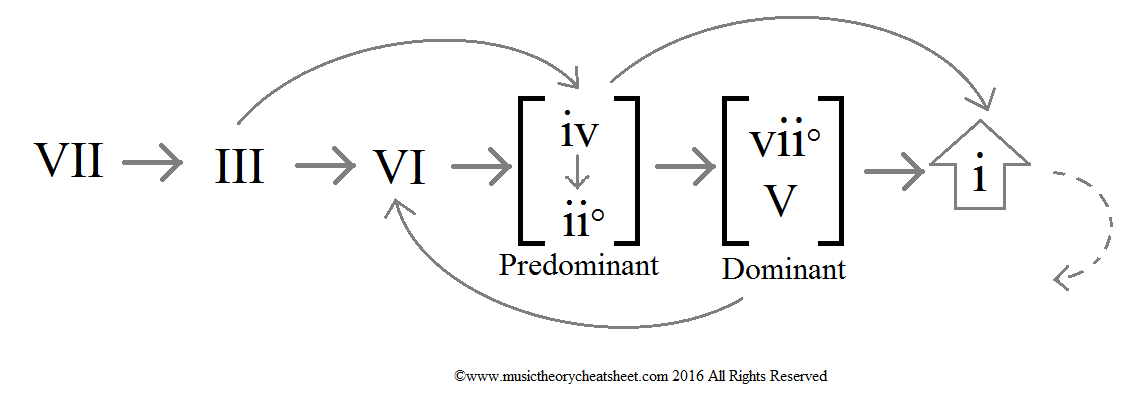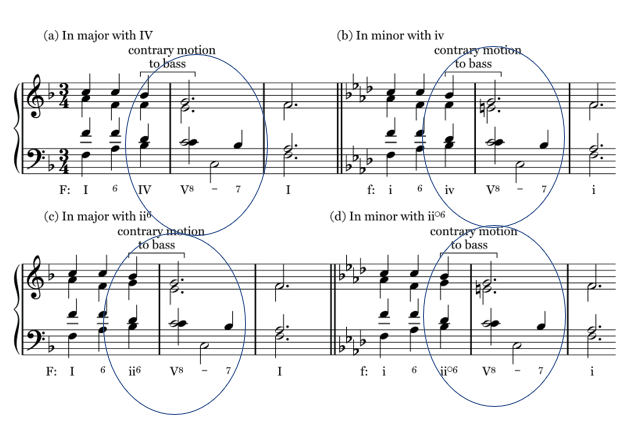Before we dive into the predominant world or even a phrase, let’s review harmonic functions.
Harmonic function refers to the role that a chord plays within a piece of music. In tonal music, chords are typically classified according to their function, with some chords serving as tonic chords (the "home" chords), others serving as dominant chords (tending to move the music "home"), and still others serving as subdominant chords (progressing towards the dominant).
Here are the chords that fall into the tonic and dominant categories. Check out
Unit 4.3 if you need a quick refresher on tonic and dominant harmonic functions! Always remember that these can be either in a major or minor key.
Image from: http://openmusictheory.com/harmonicFunctions.html
In unit 4, we discussed how a dominant-tonic motion completes the basic phrase structure, and this is called a cadence. We also discussed how phrases usually begin on tonic chords. The phrases that move from a series of tonic chords (perhaps with some melodic and harmonic embellishments) to a dominant-to-tonic cadence are abbreviated as T-D-T phrases.
Tonic-Dominant-Tonic phrases usually don’t just have three or four chords. We saw earlier how we can expand the tonic area with dominant chords that act as “passing tones” between two tonic chords. One example is the I-V 4/3-I6 chord progression that creates beautiful voice exchanges between the four parts.
Later, we’ll learn more techniques to expand the tonic and dominant areas. However, we might want to add tension and harmonic interest to our phrase. We don’t want to stay in the tonic area, because it sounds boring and there is too little tension. The tonic is too stable. We also don’t want to spend too much time in the dominant section of the phrase, because by the time we get to the dominant area of the phrase, we are expecting a resolution.
The solution? Predominant chords!
There are several different chords that can function as predominant chords, depending on the specific context and musical style. In tonal music, the ii chord (the minor chord built on the second scale degree of the key) and the IV chord (the major chord built on the fourth scale degree of the key) are often used as predominant chords.
Predominant harmonies (ii and IV) – and their minor keys equivalents- are so named because they LEAD to the dominant. Just like dominant chords have a strong tendency to resolve to the tonic, predominant chords have a strong tendency to move towards the dominant. It is also easy to move from tonic chords to predominant chords.
That is, phrases that were just I-V-I can now become I-ii-V-I or I-IV-V-I. Think of the predominant section of a phrase as a preparation of the dominant. Its function is to expand the basic phrase going from T-D-T to T- PD- D- T. This type of phrase is used more frequently than T-D-T.
Here is an overview of how a T-PD-D-T phrase might look in Major keys:
Harmonic flowchart for Major Keys. Chors IV or ii serve as a Pre-Dominant function. Image from Robert Hutchinson: http://musictheory.pugetsound.edu/mt21c/HarmonicFunction.html
And here's how it might look
in a minor key:
Harmonic flowchart for minor keys. Chords iv or ii0 serve as pre-dominant function in minor keys. Image from Robert Hutchinson: http://musictheory.pugetsound.edu/mt21c/HarmonicFunction.html
Don't worry if you are unsure of how VI and III chords fit into the picture yet. We'll learn these in Units 5.2 and
5.4.
You’ve probably heard this progression several times. If you have a piano or a keyboard near you, play a I-IV-V-I progression really quickly. Have you heard these harmonies before? Chances are, it sounds familiar! The I-IV-V-I progression is really common in both popular and classical music.
Let’s talk about how to use the IV and the ii chords in chord progressions, and how to incorporate proper voice leading into and out of the predominant section.
The subdominant chord (the IV chord in Major, and the iv chord in minor) is very commonly used as the first predominant chord in a chord progression. Why? Because it is a perfect fifth below the tonic, meaning that if you are moving down the circle of fifths, you will end up going from the tonic to the IV chord.
Using the IV chord also makes it easy to move stepwise when moving from the tonic to the subdominant. Take, for example, a tonic chord in the key of F Major. The I chord will have the notes F-A-C. And, the IV chord will have the notes Bb-D-F. We retain the tonic note F, which allows us to still hang on to some of the tonic-centered sounds in the chord progression, but we also move away from the tonic section of the phrase.
Let’s look at an example derived from one of the past AP Music Theory exams:
Notice that the iv chord is inverted to a iv6 chord in first inversion. Let’s walk through a scenario in which the chord was in root position. This is perhaps more common than a subdominant chord in first inversion, especially if we were in Major key, because the root position emphasizes the predominant function of the IV chord.
If we had left the iv chord in first inversion, then we would have to put the C in the bass. Since we don’t want to move from a perfect fifth to a perfect octave we would have to put an E in the tenor. It makes sense to leave the alto voice as a G, and let the soprano voice be a C so we can double the root.
While IV chords are great as predominant chords, sometimes we just want to spice things up a little bit and add some more harmonic interest. It would be quite boring if all of the phrases in a piece were just I-IV-V-I or I-IV-vii-I phrases. Another great option for a chord with a predominant harmonic function is the supertonic chord, which is ii in Major and iio in minor.
Just like the viio chord is a weaker substitute for the V chord in the dominant section of a phrase, the ii chord is a weaker substitute for the IV chord. It is sufficient to have only a ii chord in the predominant section, but the ii chord also often comes after the IV chord to expand the predominant section. If you have both a IV chord and a ii chord in the predominant section, always put the IV chord first!
As a triad, ii chords in the predominant section are usually in first inversion (ii6 and iio6). In first inversion, the bass note will be the subdominant, which emphasizes the predominant function of the ii chord. If you want to emphasize the subdominant even more, you can also double the third in ii6 and iio6 chords.
What about the ii7 chord?
In a major scale, the ii7 chord is the second chord of the diatonic harmony and is often used as a predominant chord, meaning that it leads to the dominant chord (the chord built on the fifth scale degree). The ii7 chord can also be used as a substitute for the V7 chord (the dominant seventh chord) in a blues progression, creating a "half-step" resolution from the IV chord to the tonic chord.
In a minor scale, the ii7 chord is the ninth chord of the diatonic harmony and is often used as a tonic substitute, meaning that it can be used in place of the tonic chord to add variety to a chord progression. It can also be used as a leading chord, leading to the iii7 chord or the IV7 chord.
We’ll cover predominant seventh chords more in the one of the next units:
section 5.3!
We often use the ii chord if we are moving into a V7 chord. This is because voice leading from the IV to the V7 chord is logistically difficult, and it often sounds clunky.
As you are figuring out now, contrary motion will help us most of the time, however, there are still rules we need to double-check when writing harmonies. When a predominant chord moves to a V⁷, the chordal seventh (the seventh of the chord) needs to be prepared by a common tone. In order for that to happen, you must choose carefully which chord is appropriate while keeping in mind that a V⁷ chord has 4 notes. To avoid parallel 5ths, you must always go in contrary motion and keep common tones when possible. Here is a nice view of what your options might look like:
Image via The Musician's Guide for Theory and Analysis. Third edition.
Now that we know what the predominant chords are, we have more options or choices to create a new phrase, follow this template to construct your basic phrase- T- PD- D- T in Major:
And this template for Minor:
Images via musictheorycheatsheet.com
Remember:
Where exactly do we find the predominant section? 🤔 That's right, predominant chords come BEFORE dominant! Remember: the voice leading on a predominant must follow contrary motion against the bass. This way, you avoid parallelism (i.e. parallel fifths and octaves) as well as other voice-leading errors.
Contrary motion with bass will help you avoid voice-leading errors when working with pre-dominant chords. Image from: The Muscicians Guide for Theory and Analysis. Third edition.
